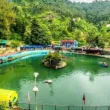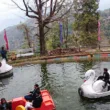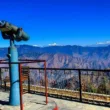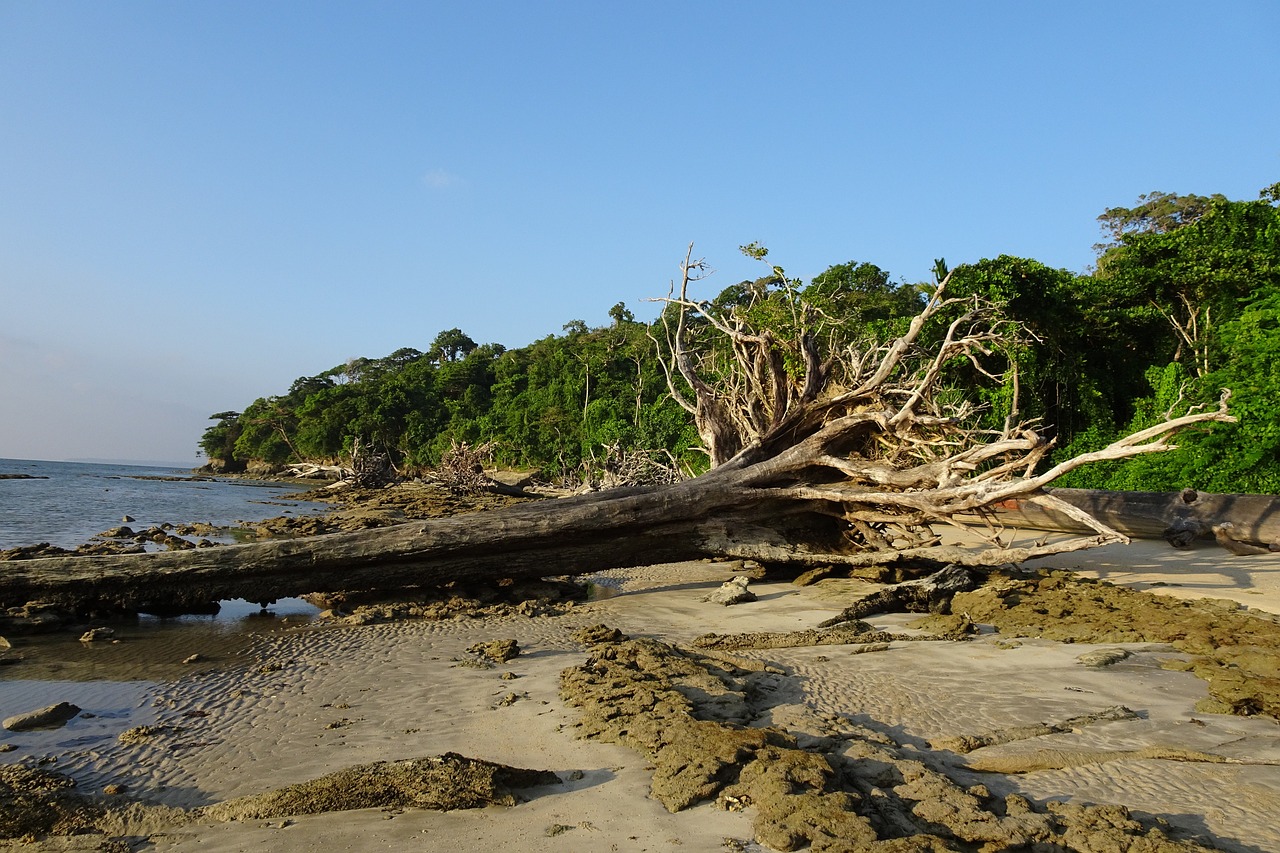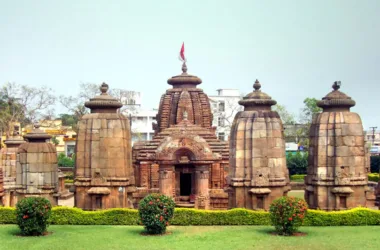Mahatma Gandhi Marine National Park, located in the Andaman and Nicobar Islands, is a protected area that encompasses 15 islands and coves. The park, which was established in 1983, is home to a diverse array of marine life, including coral reefs, mangroves, and a variety of fish and sea turtles.
One of the main attractions of the park is the coral reefs, which are home to a wide variety of colorful fish and other marine life. Visitors can take glass-bottomed boat rides to see the coral reefs up close, or go snorkeling or scuba diving to explore them in greater depth. The park also offers a number of guided tours and educational programs, which provide visitors with a deeper understanding of the marine life and ecology of the park.
In addition to its marine life, the park also features a number of other natural attractions, such as mangrove forests, sandy beaches, and rocky cliffs. The park is also home to a variety of bird species, including the Andaman wood pigeon and the Andaman cuckoo-dove.
The park is also known for its sea turtles, which come to the park’s beaches to lay their eggs. The park has a Turtle Conservation and Research Center, which monitors and protects the sea turtle populations in the park.
The park is open year-round, but the best time to visit is between December and May when the weather is mild and the seas are calm. Visitors can reach the park by taking a ferry from Port Blair, the capital of the Andaman and Nicobar Islands.
Mahatma Gandhi Marine National Park is a must-visit destination for anyone interested in marine biology, ecology, or simply enjoying the beauty of nature. With its diverse marine life, beautiful beaches, and serene atmosphere, it is a great place to relax and reconnect with nature.
Flora and Fauna at Mahatma Gandhi Marine National Park
Mahatma Gandhi Marine National Park is home to a diverse array of flora and fauna, making it a popular destination for nature enthusiasts and biologists.
The park’s coral reefs are home to a wide variety of marine life, including over 200 species of fish and more than 50 species of coral. Some of the most common fish species found in the park include butterfly fish, parrot fish, and damselfish. Visitors can also see a variety of other marine animals, such as sea turtles, octopuses, and squid.
The park also boasts a diverse array of mangroves, which provide important habitats for a variety of marine life and birds. The mangrove forests are home to a variety of bird species, such as the Andaman wood pigeon and the Andaman cuckoo-dove.
In addition to its marine life, the park is also home to a variety of terrestrial flora and fauna. Visitors can see a variety of plants, such as coconut palms, pandanus trees, and mangroves, as well as animals like monitor lizards, fruit bats, and various species of deer and monkeys.
The park is also home to sea turtles, which come to the park’s beaches to lay their eggs. The park has a Turtle Conservation and Research Center, which monitors and protects the sea turtle populations in the park.
Overall, Mahatma Gandhi Marine National Park offers a unique and rich array of flora and fauna, making it a valuable ecological and research area. Visitors can enjoy a variety of activities such as snorkeling, scuba diving, and guided tours to explore and learn about the diverse ecosystem of the park.
History of Mahatma Gandhi Marine National Park
Mahatma Gandhi Marine National Park is located in the Andaman and Nicobar Islands, a Union Territory of India. The park was established in 1983 and encompasses 15 islands and coves. The park covers an area of around 281 square kilometers and is situated in the South Andaman district of the Andaman and Nicobar Islands.
The Andaman and Nicobar Islands have a rich history, dating back to prehistoric times. The islands were first settled by indigenous tribes, who have lived there for thousands of years. The islands were also used as penal colonies by the British during the colonial era.
The park was established to protect the rich marine life and ecosystems of the Andaman and Nicobar Islands. The park’s coral reefs and mangrove forests are considered to be some of the most diverse and unique in the world. The park is also home to a number of endangered species, such as the Andaman teal, the Andaman serpent eagle, and the Nicobar megapode.
In the past, the park faced a number of threats from human activities, such as illegal fishing, pollution, and habitat destruction. However, the park has implemented a number of conservation and management measures to protect its ecosystems and wildlife. These measures include the creation of marine protected areas, the implementation of strict regulations on fishing and other activities, and the development of ecotourism and education programs.
Today, Mahatma Gandhi Marine National Park is a popular destination for ecotourism and nature-based activities. Visitors can take glass-bottomed boat rides, go snorkeling, or scuba diving to explore the coral reefs, mangrove forests, and other ecosystems of the park. The park also offers a number of guided tours and educational programs to help visitors learn more about the park’s ecosystems and conservation efforts.
Best Time To Visit Mahatma Gandhi Marine National Park
The best time to visit Mahatma Gandhi Marine National Park is between December and May. This time period offers the most comfortable weather conditions, with mild temperatures and low humidity. The seas are also calm during this time, making it the ideal season for activities such as snorkeling, scuba diving, and boat rides to view the coral reefs and other marine life.
The park is open year-round, but the monsoon season, which runs from June to September, can be challenging for visitors. Heavy rains and strong winds can make it difficult to access the park and participate in water-based activities. Additionally, the seas can be rough during this time, making it difficult to navigate and potentially dangerous for visitors.
It’s also worth noting that the park is closed for maintenance for a few days around the year, so it’s best to check with the park authorities before planning your visit.
In summary, the best time to visit Mahatma Gandhi Marine National Park is from December to May, when the weather is mild and the seas are calm, making it the perfect time to explore the park’s rich marine life and beautiful beaches.
Stays near Mahatma Gandhi Marine National Park
If you’re looking for stays near the Mahatma Gandhi Marine National Park, there are a few options available. One of the closest options is to stay in Wandoor, which is the nearest town to the park and the main point of entry. There are several resorts and hotels available in Wandoor that offer comfortable accommodations and easy access to the park. Another option is to stay on one of the islands in the park, such as Jolly Buoy Island or Red Skin Island, which offer unique and secluded accommodation options such as tents or cottages. These options are usually operated by the park authorities and can be booked in advance. You can also find other options such as homestays, guest houses, and vacation rentals in and around the nearby towns, such as Port Blair and Rangat. It’s always recommended to check for reviews, prices, and availability before making a reservation.
Please keep in mind that the park is open only for a limited period of time in a year and the availability of accommodation is subject to the park’s visiting season.
Tips For Visiting Mahatma Gandhi Marine National Park
Here are a few tips for visiting Mahatma Gandhi Marine National Park:
- Plan in advance: The park is open only for a limited period of time each year, and the number of visitors is restricted to preserve the natural environment. Be sure to check the park’s opening dates and make your reservations well in advance.
- Dress appropriately: The park is located on a tropical island, so be sure to dress in light, comfortable clothing and bring plenty of sunscreens. Also, it’s recommended to wear comfortable shoes or water shoes as some of the activities may involve walking on rocky or coral surfaces.
- Bring a waterproof bag: If you’re planning to go snorkeling or diving, be sure to bring a waterproof bag to keep your valuables safe and dry.
- Pack a picnic: The park has several beaches and picnic areas where you can enjoy a meal and take in the natural surroundings.
- Respect the wildlife: The park is home to a wide variety of marine life, so be sure to respect the wildlife and follow any instructions given by the park’s staff.
- Respect the coral reefs: Coral reefs are fragile ecosystems and it’s important to avoid touching, standing, or stepping on them.
- Be mindful of the tide schedule: Some of the islands and beaches within the park are only accessible during low tide, so it’s important to plan your visit accordingly.
- Be prepared for mosquitoes: as the park is located in a tropical region, it’s advisable to bring insect repellent to protect yourself from mosquitoes and other insects.
By keeping these tips in mind, you can ensure that your visit to the Mahatma Gandhi Marine National Park is safe, enjoyable, and respectful of the natural environment.
How to reach Mahatma Gandhi Marine National Park
The Mahatma Gandhi Marine National Park is located in the Andaman and Nicobar Islands, which are a union territory of India located in the Bay of Bengal. There are several ways to reach the park depending on your location and preference.
- By air: The nearest airport to the park is the Veer Savarkar International Airport in Port Blair, which is connected to major cities in India such as Kolkata, Chennai, and Bhubaneswar. From Port Blair, you can take a taxi or bus to Wandoor, which is the main point of entry to the park.
- By sea: The park can also be reached by taking a ferry or cruise ship from Port Blair to Wandoor. The journey takes about 2-3 hours, and tickets can be purchased in advance.
- By road: If you’re already in the Andaman and Nicobar Islands, you can reach the park by taking a bus or taxi from Port Blair to Wandoor. The journey takes about 2-3 hours, depending on the traffic.
Once you reach Wandoor, you will have to take a boat to reach the islands within the park. The park authorities operate regular boat services to the islands and you can book them in advance or on the spot.
Please note that the park is open only for a limited period of time each year, and the number of visitors is restricted to preserve the natural environment. Be sure to check the park’s opening dates and make your reservations well in advance.
Similar Articles
Frequently Asked Questions About Mahatma Gandhi Marine National Park
Q. When is the best time to visit the Mahatma Gandhi Marine National Park?
A – The park is open only for a limited period of time each year, usually between October and May. The best time to visit the park is during the months of December to February when the weather is pleasant and the sea is calm, making it ideal for snorkeling and diving.
Q. What are the main attractions of the Mahatma Gandhi Marine National Park?
A – The park is known for its diverse marine life and coral reefs. Visitors can see over 200 species of coral and a wide variety of fish, including butterfly fish, parrot fish, and angelfish. The park is also home to sea turtles, dolphins, and even dugongs.
Q. What activities can I do at the Mahatma Gandhi Marine National Park?
A – The park offers several activities for visitors to enjoy, including snorkeling, scuba diving, and glass-bottom boat rides. Visitors can also enjoy nature walks and beach activities.
Q. Are there any restrictions for visiting the park?
A – The park is open only for a limited period of time each year, and the number of visitors is restricted to preserve the natural environment. Visitors are also required to follow certain rules and regulations while visiting the park, such as respecting the wildlife and coral reefs, and not littering.
Q. Can I stay overnight on the islands in the park?
A – Yes, there are a few options for overnight stays on the islands in the park such as Jolly Buoy and Red Skin Islands. These options include tents and cottages, which are usually operated by the park authorities and can be booked in advance.
Q. Is it possible to go scuba diving in the park?
A – Yes, scuba diving is one of the popular activities in the park, but it’s subject to the park’s visiting season, weather conditions, and the diver’s certification level. Visitors can take a diving course or book a diving excursion from one of the diving centers in Wandoor or Port Blair.

